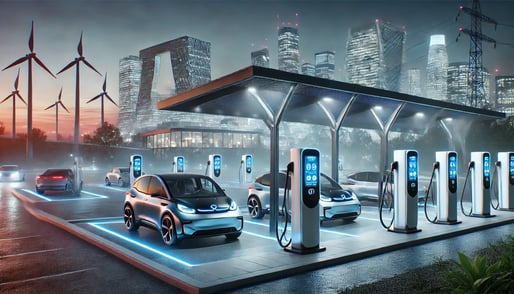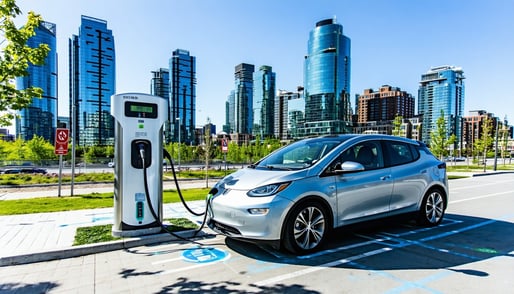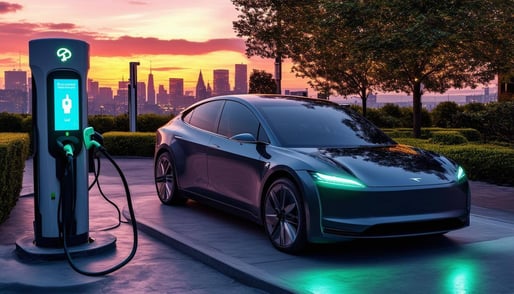As we enter the winter months in the Northern Hemisphere, many electric vehicle (EV) owners are asking the big question: How can I keep my EV performing efficiently in freezing temperatures? Cold weather isn’t just hard on us—it can also impact your EV’s battery performance, charging times, and overall range. But don’t worry! With the right preparation and a few simple strategies, you can tackle extreme winter conditions like a pro.
In this article, we’ll explain how cold weather (and other extreme conditions) affects EVs and share practical tips to keep your EV running smoothly all winter long.
How Extreme Cold Affects EV Charging Efficiency
1. Battery Performance Drops in Cold Weather
EV batteries depend on chemical reactions to store and deliver energy. Cold temperatures slow these reactions, reducing the battery's ability to discharge energy efficiently. According to the American Automobile Association (AAA), EV range can decrease by up to 41% in temperatures around 20°F (-6°C), especially when heating systems are in use.
2. Longer Charging Times
In cold weather, the Battery Management System (BMS) slows the charging process to protect the battery. Before the battery can accept a full charge, it must first warm up, leading to slower charging speeds. DC fast chargers may also reduce power in extremely low temperatures.
Tips to Mitigate Cold Weather Effects:
- Preheat Your Battery: Use your EV’s preconditioning feature while plugged in to warm up the battery for better efficiency.
- Park in a Garage: Keeping your EV in a warmer space minimizes temperature extremes.
- Limit Use of Heating Systems: Use heated seats and steering wheels instead of cabin heat to conserve energy.
How Extreme Heat Affects EV Charging Efficiency
1. Battery Overheating and Capacity Loss
High temperatures accelerate chemical reactions within the battery, which can degrade its long-term capacity. While EVs use cooling systems to manage heat, prolonged exposure can still shorten battery life. The U.S. Department of Energy emphasizes that heat stress can cause significant capacity loss over time.
2. Charging Slowdowns Due to Thermal Management
In extreme heat, EVs may throttle charging speeds to prevent battery overheating, especially during DC fast charging sessions.
Tips to Mitigate Hot Weather Effects:
- Charge During Cooler Hours: Schedule charging for early mornings or evenings to avoid peak heat.
- Park in the Shade: Reduce direct sunlight exposure to protect the car and battery.
- Monitor Battery Temperature: Use your EV’s monitoring features to ensure thermal conditions stay optimal.
The Impact of Humidity and Rain
While humidity and rain don’t directly impact EV charging efficiency, they can affect charging infrastructure:
- Moisture: Excess moisture can cause corrosion or connection issues if charging ports or cables are not properly sealed.
- Reduced Traction: Wet roads can reduce driving efficiency, slightly affecting range.
Modern EVs and charging stations are built to be weatherproof, minimizing these risks. However, regular checks remain essential.
Tips for Rainy Conditions:
- Keep Ports Dry: Use protective covers for charging ports during heavy rain.
- Inspect Equipment: Regularly check for moisture or damage in cables and ports, especially after storms.
Seasonal Weather Patterns and Long-Term Battery Health
Temperature fluctuations over the year can gradually degrade an EV battery’s health. While thermal management systems regulate temperature, cumulative effects from seasonal weather extremes can’t be ignored.
Best Practices for Long-Term Battery Health:
- Avoid Frequent Full Charges: Limit charging to 80-90% for daily use to reduce battery stress.
- Minimize Fast Charging: Use Level 2 chargers more often to avoid excess heat.
- Use Scheduled Charging: Charge your EV closer to your departure time for efficient preconditioning.
Adapting to Winter Weather for Better EV Performance
Cold weather doesn’t have to drain your EV’s efficiency—or your driving confidence. By preheating your battery, conserving energy, and parking in protected areas, you can maximize your EV’s performance even in freezing conditions.
Quick Winter Checklist for EV Owners:
✅ Precondition the battery before driving.
✅ Park in a garage or sheltered space.
✅ Use heated seats and steering wheels to conserve energy.
✅ Monitor charging times and plan ahead in extreme cold.
As EV technology advances, improvements in battery chemistry and thermal management systems will make EVs even more resilient to extreme weather. For now, small steps—like strategic charging and climate care—ensure a smooth driving experience in any climate.
Further Reading:
- AAA Study on Cold Weather Impact
- U.S. Department of Energy - EV Basics
- EV Charging: A Comprehensive Guide
For more expert insights on EV charging solutions, visit Electrum Charging Solutions blog and stay informed all year long!
Dec 20, 2024 7:00:00 PM
%20driving%20through%20a%20snowy%20winter%20road%2c%20surrounded%20by%20snow-covered%20trees.%20The%20cars%20wheels%20are%20creating%20tra.webp?width=390&height=223&name=DALL%C2%B7E%202024-12-17%2012.04.25%20-%20A%20realistic%20image%20of%20an%20electric%20vehicle%20(EV)%20driving%20through%20a%20snowy%20winter%20road%2c%20surrounded%20by%20snow-covered%20trees.%20The%20cars%20wheels%20are%20creating%20tra.webp)
%20at%20an%20EV%20charging%20station%20in%20extreme%20summer%20heat.%20The%20car%20is%20connected%20to%20the%20charger%2c%20and%20the%20sun%20is%20sh.webp?width=1792&height=1024&name=DALL%C2%B7E%202024-12-17%2012.04.28%20-%20A%20realistic%20image%20of%20an%20electric%20vehicle%20(EV)%20at%20an%20EV%20charging%20station%20in%20extreme%20summer%20heat.%20The%20car%20is%20connected%20to%20the%20charger%2c%20and%20the%20sun%20is%20sh.webp)
%20parked%20at%20an%20EV%20charging%20station%20during%20rainy%20weather.%20The%20car%20is%20plugged%20into%20the%20charger%2c%20with%20visible.webp?width=1792&height=1024&name=DALL%C2%B7E%202024-12-17%2012.25.23%20-%20A%20realistic%20image%20of%20an%20electric%20vehicle%20(EV)%20parked%20at%20an%20EV%20charging%20station%20during%20rainy%20weather.%20The%20car%20is%20plugged%20into%20the%20charger%2c%20with%20visible.webp)
%20battery%20with%20a%20stethoscope.%20The%20stethoscope%20tube%20is%20now%20fully%20e.webp?width=1792&height=1024&name=DALL%C2%B7E%202024-12-17%2012.34.25%20-%20A%20realistic%20image%20of%20a%20female%20doctor%20checking%20the%20health%20of%20an%20electric%20vehicles%20(EV)%20battery%20with%20a%20stethoscope.%20The%20stethoscope%20tube%20is%20now%20fully%20e.webp)
%20designed%20to%20appear%20as%20if%20it%20is%20wearing%20a%20large%2c%20puffy%20winter%20parka%20or%20jacket.%20The%20EV%20is%20parke.webp?width=1792&height=1024&name=DALL%C2%B7E%202024-12-17%2012.36.23%20-%20A%20creative%20and%20playful%20image%20of%20an%20electric%20vehicle%20(EV)%20designed%20to%20appear%20as%20if%20it%20is%20wearing%20a%20large%2c%20puffy%20winter%20parka%20or%20jacket.%20The%20EV%20is%20parke.webp)



Comments